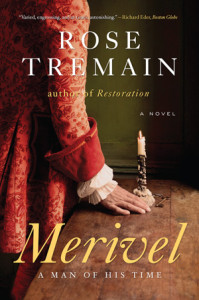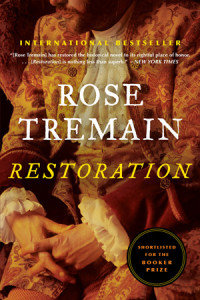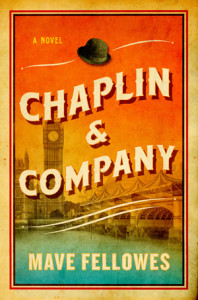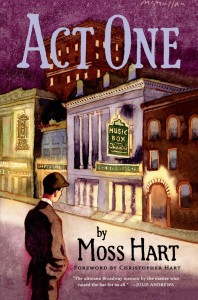King’s Fool and Friend: The Highs, Lows, and Contradictions of a 17th century man (Restoration: 1664 – 1668/England; Merivel: 1683-1685/England, France, Switzerland):
Just as Restoration opens with Sir Robert Merivel – a lavishly imagined historical character we get to know so vividly over these quick-turning 800 pages he feels real – recounting “five beginnings” of his life, let’s start by listing five ways this posting is unlike any other:
 The review is a double-package. Merivel is the sequel to Restoration, originally published in the UK in 1989, and nominated for the Man Booker Prize. I read both to see how well Merivel stands by itself. While it does (many times the reader is brought up-to-speed), you may feel greater compassion for Merivel having seen how far he’s come if you read both.
The review is a double-package. Merivel is the sequel to Restoration, originally published in the UK in 1989, and nominated for the Man Booker Prize. I read both to see how well Merivel stands by itself. While it does (many times the reader is brought up-to-speed), you may feel greater compassion for Merivel having seen how far he’s come if you read both.- 17th century England, the “Age of Possibility” when King Charles II was restored to the throne, is 200 years earlier than my historical fiction preferences.
- I love books whose prose is uplifting. But Merivel is a man of many contradictions (“I’m a paradoxical thing” he tells us) – manic and melancholy (he cries so much he wears out handkerchiefs). Since this is a penetratingly honest account of twenty years of his insatiability – insatiable lust, greed, and quest for purpose – the prose soars when his moods are joyous but plunges when he despairs.
- The prose is extraordinary but not always “enchanted.” Merivel’s younger years, in Restoration (we meet him at 37), are more hedonistic than 15 years later when we meet him again in Merivel: A Man of His Time. Sometimes the prose startles in its vulgarity and graphical depictions, but as Merivel grows more searching, loving, noble, so marks the prose. When he speaks “soul-to-soul” about his love for animals, nature, music, art, the King, Pearce, his manservant, his daughter, the prose enchants.
- The prose never feels gratuitous. In fact, Rose Tremain confirms this in her eye-opening “Afterward” to Restoration, explaining her fictional intentions. She reached far back in history to a grandiose King who had so many mistresses (at least 8 I found in historical references, claiming 17 illegitimate children), to give fictional integrity to anything goes!
The result is immersive prose, an unforgettable fellow, and a powerful warning that resonates today.
A brief timeline of Merivel’s beginnings:
1636: Merivel at age 9 performs his first dissection. Later, he excels in anatomy when he pursues medical studies in Cambridge, which explains his graphic prose
1647: Meets his Quaker friend, John Pearce (“prone to Godliness”) in college
1661: Father serves as glovemaker to restored King Charles II at Whitehall
1662: Parents perish in a fire at their haberdashery shop, humanizing the Great Fire of London 4 years later
1664: Forgoes medicine to serve the King, makes him laugh, is his tennis partner, saves his spaniel, Lou-Lou. (Animals play an important role in both novels. Not all are commonplace, like an Indian Nightingale and Clarendon, a bear.)
1664: A grateful King sets Merivel up in an estate in Norfolk that comes with a monthly stipend on the condition that he marries, in name only, one of his mistresses, Celia Clemence. Merivel must promise not to love her for she belongs to the King, who wants to placate a jealous mistress, Lady Castlemaine. Poor Queen Catherine! (She does not produce any heirs.)
Bidnold, Merivels’ estate, looms large. As he delights in changing its character, he reveals some of his:
“It was a Jacobean manor, moated and bordered by a substantial park … Though struck by its drabness, I rejoiced in it. For from these plain rooms, I decided at once, I would fashion interiors that reflected, in their crimsons and vermillions, in their ochres and golds, in their abundance of colour and light, my own excessive and uncontainable nature.”
Bidnold may be magnificent, but the countryside is isolating and brutal in the winter, triggering loneliness and boredom for the restless Merivel. Without doctoring, he must find other means for “enlightenment.” He starts by aspiring to be an artist, hoping the painting “as wild, as undisciplined, as excessive as my own character” will “make me whole.” His attempts to play the oboe, lead him to wonder: “Does music teach wisdom?” “Does it civilize the soul?” What music does is awaken him to the beautiful voice of his wife, hence her beauty, hence his downfall.
Merivel’s adventures take many roads. One leads to re-discovering his old friend Pearce at Whittlesea, a Quaker mental hospital, where he joins the staff in the “service of the common good.” Within this bedlam, he further disgraces himself by impregnating Katherine, a patient. As Restoration draws towards its ending, sadly, this will not be the only time Merivel mourns his “beastliness” and “the peculiar ways in which, without meaning to, we sometimes bind ourselves to another person for all eternity.”
Merivel: A Man of His Time opens with Merivel’s adoration for his seventeen-year-old daughter, Margaret, strengthening his likability. When she departs with friends for Cornwall his depression deepens, along with self-reflections. Tremain cleverly capitalizes his Feelings and Thoughts, emphasizing them. Loneliness, Poverty, Poisoning, Suicide, and Meaninglessness are laid bare as five possible endings for Merivel’s destiny.
Still, he yearns for Wonders. So Merivel dreams up the idea of traveling to Versailles, where King Louis XIV reigns, King Charles’ cousin. Clutching the King’s letter of introduction, he hopes to serve another monarch. Versailles, a “Song of Magnificence and Beauty,” dazzles him, like the room with 100 mirrors. Along the way, he encounters a Dutch clockmaker, Hans, who signals a theme of time, ever more pressing. Merivel is also touched by the predicament of a caged bear (“I don’t know why the plight of animals moves me so greatly. Perhaps it is that I have never overcome my own Animal Nature”); poverty (“the great scourge across the land”), and a woman he meets, Madame Louise de Flamanville, whose father owns a chateau in Switzerland. He is now 57 years old and craving Lightness of Heart.
As Merivel struggles to find peace, we cannot read fast enough to learn whether he has predicted his destiny. By now, we care about this flawed, passionate, charitable, philosophical man. When at last we find him ensconced in a comforting room back at his beloved Bidnold, reflecting on how much he “liked to sit, sometimes, and watch the Alterations of the sky, and listen to the wind, and feel that I was above the world and yet floating in its beauty, like a cloud,” we so wish his destiny to be floating in beauty. But Merivel is a most contradictory soul, whose spirit we’ve come to know rather intimately. So we brace ourselves for the coming clouds.
Lorraine




